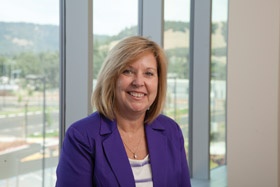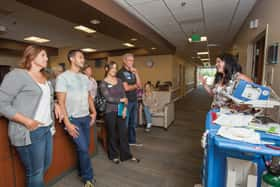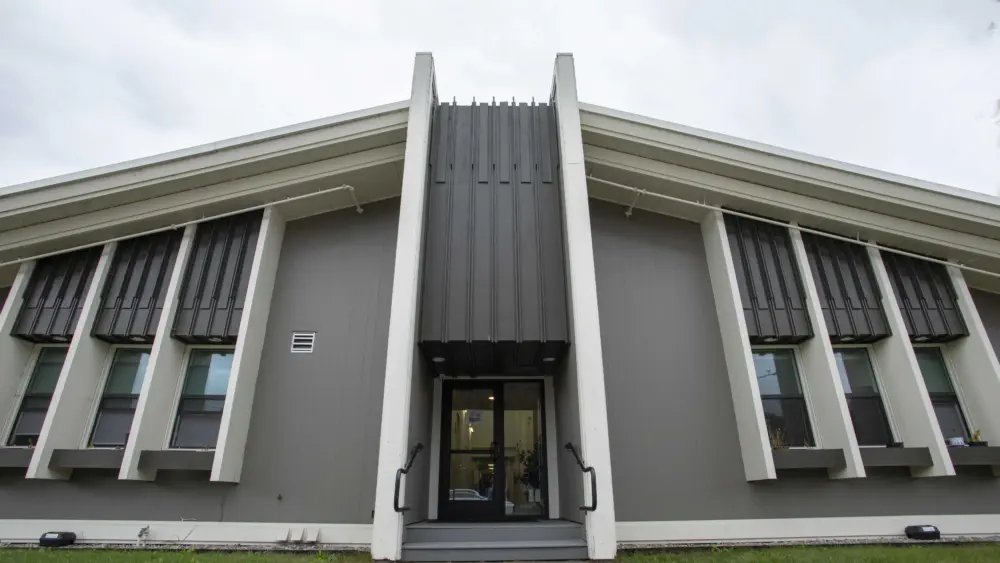Moving a hospital is tricky business.
On Saturday, October 25, 2014, two years of details will come down to one day, as the first patients at Sutter Medical Center of Santa Rosa on Chanate Road will be loaded into ambulances and transported to the new Sutter Santa Rosa Regional Hospital, which will officially open its doors for business at 0700 hours (that’s 7 a.m. hospital time).
Moving a household is a monumental task with hundreds of details to oversee. But when you’re in the business of health care and operate 24 hours per day, seven days per week, there are thousands of details—and there’s no closing shop for the day. There are still babies to be born, broken bones to be set and emergency appendectomies to perform, not to mention the matter of transporting patients to the new location. There can be no mistakes, and there’s no room for error. That’s why Sutter Health has been preparing for this move for more than two years.
Before any patient leaves the Chanate Road hospital, a staff member will alert a “command center” at the new location that the patient is in transport. “Each step of the move will be tracked through dual command centers, one at each location, much like you track a FedEx package,” says Tom Minard, senior project manager of facility and property services at Sutter Health. (See “Command Center,” below.)
What does it take to move a hospital?
First, it takes a battalion of 800 people and an orchestrated effort to get the job done. Second, there’s the cost—more than $7 million to plan the transition, educate and train staff, and move people and equipment five miles to the new hospital on Mark West Springs Road. “On the day of the move, we’ll be running two hospitals, and the hospital on Chanate will stay open until the last patient is cared for and transferred,” says Minard.

To smooth the way, Sutter Health employed a hospital moving consulting firm, RTKL (based in Dallas, Tex.), to guide the project, and appointed one of its own nurses, Robin Allen, to spearhead the process. In addition, 12 focus group leaders are assigned to manage various details of the move such as safety; operations (admissions and patient tracking); regulatory details for 50 licenses that must be reapplied for the pharmacy, radiology equipment and more; planning; logistics; and communications. What’s more, a Saturday move-in was selected to help ease the process with an expected lower patient population, fewer medical procedures scheduled and less traffic to contend with.
Why is it especially important to be organized when moving a hospital? “The major reason is the safety of our patients,” says Allen, facility project planning director for the hospital move. “We’ve developed timelines and milestones to make sure we complete all tasks and processes to assure a safe and successful move.”
Stock and staff
While October 25 is the most critical day, some portions of the move will occur in earlier stages, officially known as “stock and staff.”
“Stock and staff” is a term used by the Office of Statewide Health Planning and Development (OSHPD). “It’s a standard OSHPD term, meaning we can move staff into the building, train staff and stock rooms and shelves,” says Minard.

Training is a key part of the stock-and-staff phase, since all technology at the new hospital is new. Staff has been undergoing training for months to learn all new building systems, including a new phone system, security system, nurse call system and pneumatic tube system. This month, Sutter Health staff will receive training to make the transition from paper records to a new electronic health records (EHR) system. Overall, Sutter Health anticipates more than 54,000 hours of training to learn all new building systems as well the new EHR.
“After stock and staff, and a month before opening, the California Department of Public Health [CDPH], completes a week-long, intensive survey to confirm that the hospital is ready for patient care and then gives the hospital the license to finally operate,” explains Minard. Once the hospital gets the green light from CDPH, the move will begin in earnest.
A company that specializes in hospital moves,
Beltmann Group (specifically the relocation team based in Albuquerque, N.M.), will transport all equipment from one hospital to the other. Managers and directors of the hospital have been assigned to one of 12 different focus groups to initiate the move. The equipment and furniture focus group will coordinate the logistics of about 1,500 items that will be moved from the Chanate facility and have created a dock management plan for more than 9,000 new pieces of equipment that have been delivered to the new hospital. Employees dubbed “move captains” will assist the move logistics group to identify equipment to be moved and purchased. The department activation group will coordinate the plan for determining the location of all equipment, furniture and supplies in the new hospital.
Bio-med carwash
Making sure the equipment is transported safely to the new hospital is one thing, but it’s another making sure it’s clean and working properly when it arrives. All bio-med items will be tagged with a “Needs Bio-Med Check” label to assure it goes to a special planning station or is checked if delivered directly to its designated department. All equipment requires bio-med testing to ensure life safety by checking it for issues such as calibration accuracy and electrical safety.
Disinfecting all equipment is another important part of the process for the pieces being moved as well as the new equipment. Beltmann Group works with Sutter’s infection control and environmental services departments to ensure every piece of equipment is properly disinfected to keep microorganisms out of the hospital.
When the equipment arrives at the new hospital’s dock, a “bio-med carwash” will be in place to make sure all items are cleaned and checked over before being delivered to the appropriate hospital unit. A more thorough cleaning will take place once the item is delivered to its designated unit.
Patient preparations and drills
Elective surgeries at the hospital will take place early in the week to make sure patients get the care they need and to keep the patient population down before the move. Then on Wednesday, October 23, interventional procedures (such as planned C-sections) as well as elective surgeries will not be scheduled. If necessary, emergency surgeries will take place at both locations the day of the move, and the Chanate emergency room will remain open until the last patient is moved.
In preparation of patient move-in day, plans are in place to practice the move twice to ensure all goes smoothly. The first practice drill takes place October 2, and the second will take place 10 days before the move with a full-blown, mock drill, complete with 20 pretend patients (including mothers with newborns), assigned diagnoses, mock medical complications and even less urgent complications such as an overflowing sink in a patient room.
“We want to think through every risk factor,” says Allen. “The mock exercises will let us go through the process of moving a patient, understand what to do if there’s a complication and how to communicate that with the command center.”
“Safety is our number one concern. We need to practice to make sure everyone is on the same page,” says Lisa Amador, strategy and business development executive of Sutter Health.
Tag-team moving
Moving patients from one hospital to the next will require a coordinated tracking effort. There will be two move teams—a red team and a blue team—at each hospital. About 36 staff members at each hospital will support the move teams. Each move team will include a move facilitator, respiratory therapist, transporter, safety observer, information technology support, a clean-up team and security and ambulance personnel.
The day before the move, Sutter Health staff members will visit with patients and their families to prepare them for moving day.
Ambulance service will be provided by Verihealth to transport patients to the new facility. “There will be 14 ambulances, and a patient will be moved every six to eight minutes,” says Allen. Each patient will be accompanied by a nurse; if a patient is on a ventilator, they will be transported via critical care transport (extra respiratory therapists will be available if needed). Family members may drive to the new facility in their own vehicles or take advantage of a special shuttle service for employees and family that day.
Amador estimates that 69 patients will be making the move to the new hospital on October 25, and all patients are expected to arrive at the new hospital by 1 p.m., where they’ll enjoy lunch once they’re settled.
What about mothers in labor and babies on Chanate? “Mothers and babies will move together, but be counted as two patients,” says Allen. “And if a mother is in the process of delivery at the hospital on Chanate, she will give birth there before making the move.”
To guarantee patient moves are fully secure, everyone will enter the hospital through one door, and security will have a list of names to check off. Families will enter the new hospital at the garden entrance, which is near the main entrance. They can enjoy refreshments at the Bistro while patients are settling in. Later, families will be escorted by staff members to the patient care areas.
Electronic health records
While going from paper medical records to electronic is a major transition for any hospital, Sutter Health plans to make the switch to an EHR system the same day it moves. A patient’s paper records and charts will be transported with the accompanying nurse during the move. “By the time a patient has arrived at the new location, his or her name and information will be on file electronically,” explains Allen. “As patients are discharged at the completion of their stay, the paper records will go away [and be stored].”
Currently, the Sutter Health team and physicians are in the process of training for the new EHR system. “We will use paper records until patients are transferred to the new facility,” says Allen. “Staff participation and training for the new electronic health records system is amazing.”
Gearing up for the move
As Sutter Health prepares for the move—now just one month away—staff members are looking forward to working at the new location. Almost every hospital employee will pull a shift on move-in day.
“Our staff is engaged and excited about the move,” says Allen. How is she managing the stress of spearheading a project of this magnitude? “It’s exciting and a once-in-a-lifetime opportunity,” she says. “I’m grateful to have it and to work with an incredible team of folks here. As the day gets closer, it is stressful, but I’m a big list-maker. That’s how I keep myself on track.”
As for working in a new environment that features cutting-edge technology, fresh local foods and patient suites with vineyard and mountain views, well, the staff is looking forward to settling into its new hospital home.
“Employees are ecstatic about the environment’s look and feel. Our care today at the hospital is top quality, but now, we’ll have a place that matches the care in a state-of-the-art facility focused on patient-centered care,” says Amador. “It’s infectious—which is probably not the most appropriate word to use in health care—but everyone is excited. It’s been a long time coming, and it’s nearly here. Sutter Health is raising the standard of health care in Sonoma County.”
You’re Invited
The new Sutter Santa Rosa Regional Hospital will host a Grand Preview Event and celebration for the public on Saturday, October 4, from 1 to 4 p.m. Patrick Fry, chief executive officer of Sutter Health, will be at the event to greet guests, as will other Sutter Health staff members.
There will be tours of the new hospital and entertainment by the Windsor Performing Arts Academy, Winsor High School, Cardinal Newman High School and Rincon Valley Christian School. The Sonoma County Bicycle Coalition and Girl Scouts of Northern California will also join the celebration. What’s more, Verihealth will be on hand, showcasing one of the ambulances that patients will be riding in on move-in day.
Numbers Tell the Story
During the course of a single Saturday, Sutter Health will move to its new, seismically safe location on Mark West Springs Road, Sutter Santa Rosa Regional Hospital. Hospital relocations are complicated, and the numbers tell part of the story:
• The cost to move patients and equipment adds up to more than $7 million;
• About 800 people will be on hand to make the move happen;
• An estimated 69 patients will make the move;
• 14 ambulances will transport patients;
• More than 300 processes will change for the Sutter Health team and how it’ll work at the new location;
• Thousands of policies and procedures (including operational policies, clinical and nonclinical) will be updated prior to the patient move;
• About 1,500 pieces of equipment will be moved;
• About 9,000 new pieces of equipment have been acquired for the new location; and
• Staff has undergone approximately 54,000 hours of training to learn new building systems and the new EHR system.
Did You Know?
The county of Sonoma built the facility on Chanate Road in 1932. Later, two additions were added, in 1956 and 1972. Sutter Health took over hospital operations and leased the facility beginning in 1996. After the move, the Chanate facility, which has been leased by Sutter Health, will return to the county of
Sonoma (which has not announced any plans for the site).
Command Center
On October 25, a command center will be in place at each Sutter hospital location to track each step of the patient moving process. The command center is modeled after the Hospital Incident Command System (HICS), which is intended for use in both emergency and non-emergency situations. It provides U.S. hospitals with tools needed to advance their emergency preparedness and response capability.
The administration area on the second floor of the new hospital will serve as the official command center, and a satellite command center will be in place at the hospital on Chanate. The command center at the new hospital will be operational 24 hours per day on both Saturday and Sunday to ensure a safe move and that all operations of the new hospital are working properly. “[The] reason the command center will stay open post-move is to continue to have a central place where all issues can be addressed quickly and efficiently,” says Sutter Health’s Tom Minard. “It’s for safety always.”
In addition, a separate information technology (IT) control center will be in place at the new facility to make certain the transition to an electronic health records system proceeds with ease.
-
Karen Hart is the editor of NorthBay biz magazine, keeping her finger on the pulse of the North Bay, directing content and leading day-to-day operations of the editorial team. An award-winning writer, Karen brings more than 30 years of experience to the position. She is a member of the California Writers Club, and serves on the Journalism Advisory Council at Santa Rosa Junior College. She moved to Sonoma County in 2000, and she’s here to stay.
View all posts
 To smooth the way, Sutter Health employed a hospital moving consulting firm, RTKL (based in Dallas, Tex.), to guide the project, and appointed one of its own nurses, Robin Allen, to spearhead the process. In addition, 12 focus group leaders are assigned to manage various details of the move such as safety; operations (admissions and patient tracking); regulatory details for 50 licenses that must be reapplied for the pharmacy, radiology equipment and more; planning; logistics; and communications. What’s more, a Saturday move-in was selected to help ease the process with an expected lower patient population, fewer medical procedures scheduled and less traffic to contend with.
To smooth the way, Sutter Health employed a hospital moving consulting firm, RTKL (based in Dallas, Tex.), to guide the project, and appointed one of its own nurses, Robin Allen, to spearhead the process. In addition, 12 focus group leaders are assigned to manage various details of the move such as safety; operations (admissions and patient tracking); regulatory details for 50 licenses that must be reapplied for the pharmacy, radiology equipment and more; planning; logistics; and communications. What’s more, a Saturday move-in was selected to help ease the process with an expected lower patient population, fewer medical procedures scheduled and less traffic to contend with. Training is a key part of the stock-and-staff phase, since all technology at the new hospital is new. Staff has been undergoing training for months to learn all new building systems, including a new phone system, security system, nurse call system and pneumatic tube system. This month, Sutter Health staff will receive training to make the transition from paper records to a new electronic health records (EHR) system. Overall, Sutter Health anticipates more than 54,000 hours of training to learn all new building systems as well the new EHR.
Training is a key part of the stock-and-staff phase, since all technology at the new hospital is new. Staff has been undergoing training for months to learn all new building systems, including a new phone system, security system, nurse call system and pneumatic tube system. This month, Sutter Health staff will receive training to make the transition from paper records to a new electronic health records (EHR) system. Overall, Sutter Health anticipates more than 54,000 hours of training to learn all new building systems as well the new EHR.



